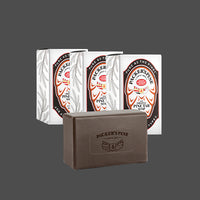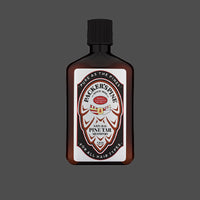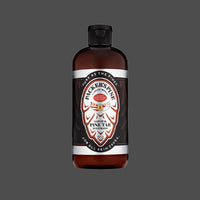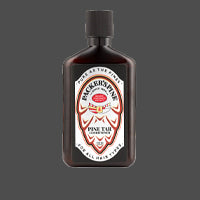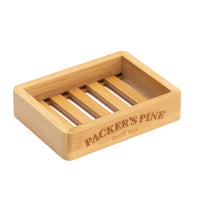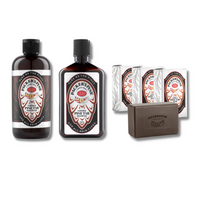Pine Tar Soap for Seborrheic Dermatitis

There’s something about having an active scalp condition that makes it difficult to feel comfortable in your own skin. We get it. When your scalp starts itching and flaking, it can be painful just to wash your hair or venture out into the cold. And indoor settings can be just as bad due to forced air heating systems that make the itch even worse.
If you’ve never tried pine tar soap for seborrheic dermatitis, you could be in for a surprise. Pine tar goes back thousands of years as a treatment for a wide variety of skin conditions, and it’s still in use in much the same way today. Studies have shown pine tar to have a positive effect on skin conditions as diverse as chickenpox, fungal and bacterial infections, bug bite reactions, heat rash, and diaper rash. This is apparently because pine tar effectively cleans the skin and may even prevent the DNA replication of diseased cells.
Because so many people—more than 10 percent of the population by some estimates—experience seborrheic dermatitis, we’ve developed a pine tar shampoo that many of our customers find effective in helping to control seborrheic dermatitis. It’s important to clean the scalp thoroughly yet gently to keep it clean and give the surface of the skin a chance to heal.
Symptoms of Seborrheic Dermatitis
Seborrheic dermatitis is often considered to be interchangeable with dandruff. It is a type of dandruff, however, that sheds extra large flakes that tend to be yellowish and oily. The usual dry white flakes may also be present. Scaly, inflamed patches are also common.
Seborrheic dermatitis is often found on the scalp, but not exclusively. It may also appear on parts of the body that tend to be more oily, including facial skin, places where skin folds or creases, on the upper back and chest, and even in the eyebrows.
Seborrheic Dermatitis in Infants
Cradle cap is the infantile form of seborrheic dermatitis. It causes scaly, crusty patches on the infant’s scalp as well as oily patches. Generally these are not itchy, but the scales don’t break free from the skin easily, so it may hang around for a while. There is usually not a reason to treat cradle cap unless the baby seems to be itching it, or if it is spreading from the scalp to other parts of the body. Cradle cap usually resolves on its own in the first year of life, but a mild shampoo and soft brush will help to keep the area clean and clear of the flakes of dead skin that build up. Occasionally, the skin may crack or bleed.
Packer’s Pine has created a pine tar shampoo especially for seborrheic dermatitis and other scalp conditions. Try using a small amount diluted in water on your infant’s scalp to keep their skin cool and oil free without stripping.
What Causes Seborrheic Dermatitis?
It is often unclear what causes seborrheic dermatitis in a particular case. Seborrheic dermatitis tends to co-present with other health conditions, including cancer, AIDS, Parkinson’s disease and other neurological conditions, and certain depressive disorders.
While no direct connection between seborrheic dermatitis and food allergies has been established, it hasn’t been ruled out, either. Allergy testing could be beneficial in helping to identify the causes of systemic inflammation that could contribute to seborrheic dermatitis.
Malassezia fungi may be implicated as a cause of seborrheic dermatitis. Because stress may also play a role, exercise, downtime, yoga and meditation, and other relaxing activities may help. Hormonal imbalances, harsh shampoos, and winter weather may also trigger seborrheic dermatitis. The condition is also thought to run in families.
Natural Remedies for Seborrheic Dermatitis
Probiotics—If all the studies are true, then a great deal of health begins with gut health. It’s not such a stretch anymore to think that poor gut health may be reflected in the skin. Working to improve your gut may not have an immediate effect on seborrheic dermatitis, but you may see changes over time.
Fish oil supplements—Fish oil supports your skin from the inside with healing omega 3 fatty acids. Stick with it every day for a month before you expect to see results.
Apple cider vinegar—Similar to pine tar, apple cider vinegar seems to have a positive effect on a surprisingly wide array of skin conditions, from warts to acne. Rinse or soak the affected area with apple cider vinegar before applying pine tar soap or shampoo to pack a double punch.
Tea Tree Oil—Terpinen, one of the active ingredients in tea tree oil, may have antifungal action. Try adding a few drops to some olive oil and rubbing it into your hair. Leave for an hour, then use our pine tar shampoo to rinse the oil completely without stripping your scalp.
Get some sun—UV rays can be healing for seborrheic dermatitis, perhaps neutralizing bacteria and drying out the rash. Be careful not to overdo it and get a sunburn, which could irritate the skin further.
Why is Pine Tar Soap Good for Skin Conditions?
Pine tar is derived from pine wood. When it is compressed and heated to very high temperatures, it releases natural but powerful substances that have an antifungal, antibacterial, and antiseptic effect on skin. These substances are in their natural concentration and balance in pine tar, and we take the extra step of removing the toxic creosote which results from the heating process, ensuring that you get the cleanest, most effective anti-itch soap possible
Many of our customers swear by pine tar soap for seborrheic dermatitis—and that’s not the only skin condition they use it for. Pine tar soap is an all-purpose anti-itch cleanser that many people would never be without. Keeping a bar in your gym bag, in the car, and in the bathroom will ensure that you are ready for any circumstance when itchy skin makes an unexpected appearance!
How to Use Pine Tar Soap for Seborrheic Dermatitis
Depending on the location of your dry skin, choose either a bar of pine tar soap or our pine tar shampoo. You could also use our pine tar body wash as an addition to your bath water. Lather up the affected area with your choice of pine tar soap and leave on for at least a minute before rinsing. Once out of the shower, pat your skin dry without rubbing.




